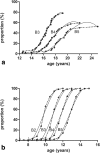The pubertal development mode of Chinese girls with turner syndrome undergoing hormone replacement therapy
- PMID: 31296213
- PMCID: PMC6625027
- DOI: 10.1186/s12902-019-0403-2
The pubertal development mode of Chinese girls with turner syndrome undergoing hormone replacement therapy
Abstract
Background: Further knowledge about the pubertal development mode of girls with Turner syndrome (TS) who have undergone hormone replacement therapy (HRT) is beneficial to the proposal of an optimal HRT regimen. This study examined the pubertal development mode of girls with TS who underwent HRT and evaluated the characteristics of optimal sex induction therapy in girls with TS.
Method: We conducted a retrospective, longitudinal study over the past two decades at The First Affiliated Hospital, Sun Yat-sen University.
Patients: Seventy-one patients with TS and two groups of normal Chinese girls.
Results: The total investigation time was 3.00 (2.00, 4.66) years. The interval of each stage was significantly longer (P < 0.001) in the girls with TS than that in the normal Chinese girls, except for B2-3 (P = 0.011). The uterine volumes of the girls with TS in stages B2 and 3 were greater than those of the control group (P = 0.046), whereas the uterine volume of the control group was inversely greater than that of the TS group among those who reached stages B4 and 5 (P = 0.034). During HRT, the uterine volume grew significantly from all previous stages except for breast stage 5 (B3 vs.2: Z = - 2.031; P = 0.042; B4 vs. 3: Z = - 2.273; P = 0.023; B5 vs. 4: Z = - 1.368; P = 0.171). The paired data of 27 girls with TS showed that the uterine volume (17.93 ± 9.31 ml vs. 13.75 ± 6.67 ml) and width (2.54 ± 0.66 cm vs. 2.22 ± 0.36 cm) increased significantly during artificial cycles compared with before artificial cycles (t = - 2.79 and - 2.51, P = 0.01 and 0.018).
Conclusion: HRT led to normal breast development in girls with TS; half of the girls with TS in our study reached Tanner stage B5, although the uterus ultimately developed suboptimally. The girls' breasts and uteruses grew quickly at the beginning of HRT (stages B2-4). An optimal HRT regimen for girls with TS may specifically focus on Tanner stages B2-4 and artificial cycles.
Keywords: Breast; Hormone replacement therapy (HRT); Tanner stage; Turner syndrome; Uterus.
Conflict of interest statement
The authors declare that they have no competing interests.
Figures

Similar articles
-
Adrenarche and pubarche in girls with turner syndrome during growth-promoting therapy with human growth hormone.BMC Endocr Disord. 2019 Jan 18;19(1):9. doi: 10.1186/s12902-019-0333-z. BMC Endocr Disord. 2019. PMID: 30658614 Free PMC article.
-
Puberty induction in Turner syndrome: results of oestrogen treatment on development of secondary sexual characteristics, uterine dimensions and serum hormone levels.Clin Endocrinol (Oxf). 2009 Feb;70(2):265-73. doi: 10.1111/j.1365-2265.2008.03446.x. Clin Endocrinol (Oxf). 2009. PMID: 19200215 Clinical Trial.
-
Oral Hormone Replacement Therapy and Uterine Volume in Korean Adolescents with Turner Syndrome: A Retrospective Case-Control Study.J Pediatr Adolesc Gynecol. 2024 Dec;37(6):555-560. doi: 10.1016/j.jpag.2024.06.006. Epub 2024 Jun 19. J Pediatr Adolesc Gynecol. 2024. PMID: 38906216
-
Growth in girls with Turner syndrome.Front Endocrinol (Lausanne). 2023 Jan 12;13:1068128. doi: 10.3389/fendo.2022.1068128. eCollection 2022. Front Endocrinol (Lausanne). 2023. PMID: 36714599 Free PMC article. Review.
-
Optimal Pubertal Induction in Girls with Turner Syndrome Using Either Oral or Transdermal Estradiol: A Proposed Modern Strategy.Horm Res Paediatr. 2019;91(3):153-163. doi: 10.1159/000500050. Epub 2019 Jun 5. Horm Res Paediatr. 2019. PMID: 31167218 Review.
Cited by
-
Effects of Psychosomatic Mutual Aid Treatment on Anxiety and Depression in Turner Syndrome.Front Psychiatry. 2021 May 10;12:644147. doi: 10.3389/fpsyt.2021.644147. eCollection 2021. Front Psychiatry. 2021. PMID: 34040554 Free PMC article.
References
MeSH terms
LinkOut - more resources
Full Text Sources
Medical
Miscellaneous

